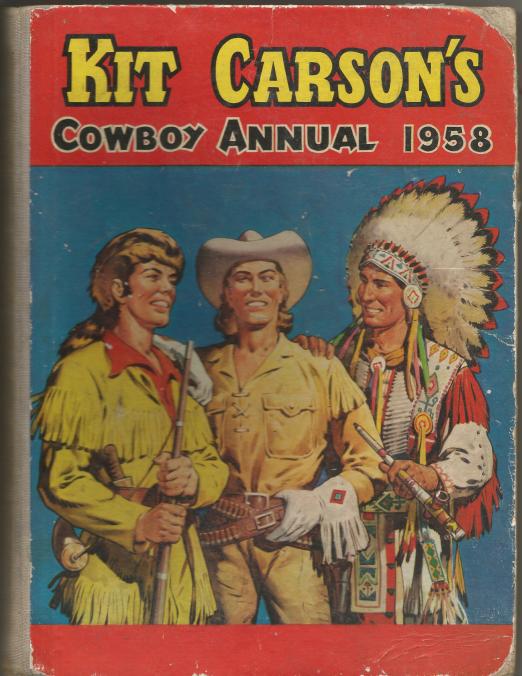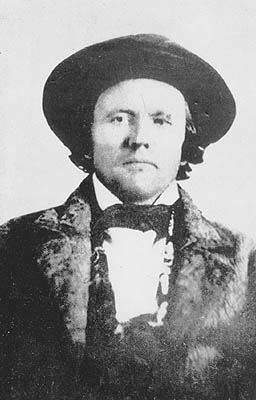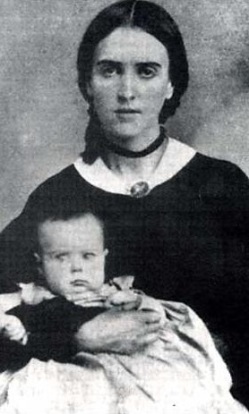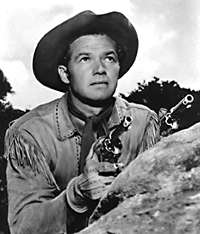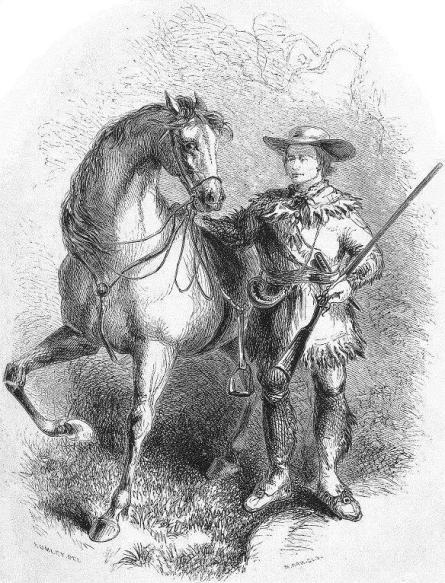I WAS RUMMAGING though some of my books the other day and came across my Kit Carson’s Cowboy Annual of 1958 which had somehow survived my childhood. This particular volume includes a couple of tales of Davy Crockett. Great ‘Boys Own Adventure’ stuff! Of course in those days I assumed these were real characters until one of my ‘friends’ ruined it all by telling me they were only heroic fellows of some writer’s vivid imagination. Bit like hearing Santa Claus is not …… no, I can’t say it. Well, just how wrong was my friend! But I think it took me several years to find out.
My 1958 Annual – Davy Crockett, Kit Carson, and friendly Native-American (I think he’s Chief Bear Paw from one of the the Davy Crockett yarns in the annual)
If you want more on Davy Crockett, see my Alamo post, August 16, 2014. As for Kit Carson, or to be more precise, Christopher ‘Kit’ Houston Carson, he was born in Madison County, Kentucky in December 1809. He began his working life as a saddler but that was not for him. He lasted two years at that and then, at the age of sixteen, he joined a group of traders bound for Santa Fe, New Mexico. He learnt (and interpreted) Spanish, worked at a variety of tasks including cook, wagon driver, and in a copper mine, before linking up with a fur trapping party heading for California. He spent a year trapping along the rivers of Arizona and southern California before returning to New Mexico, in 1831, to join the trapper, Thomas Fitzpatrick. With his band of men he headed for the Rocky Mountains. He spent ten years travelling around Western America learning of all the routes and passages through the territories.
During this period he came in contact with the Indians (I know we must call them Native Americans but I have to use the old phrase for context). Then in 1836, he married an Arapaho woman named Waanibe (Singing Grass), and had two children of which only one survived (Adeline). His wife also died in about 1841 giving birth to the second child. He married again, this time to a Cheyenne woman named Making-Out-Road (don’t ask), but it did not last. He then split the next eight years between his daughter who was being educated in St Louis (and staying with Carson’s sister) and trapping in Taos, New Mexico.
In case you didn’t know the whereabouts of New Mexico
In 1842 he met a traveller/explorer, John C. Frémont, in St Louis. Frémont was planning to survey a route to the west – to be known as the Oregon Trail – and Carson was to be his guide. Three expeditions took place between 1842 and 1845 and both Frémont and Carson had their reputations sealed – Frémont as an explorer and Carson as a frontiersman guide. The American public was fascinated by tales from the Wild West, of Indians and trail blazers, and of unsettled land ‘there for the taking’. In 1843 Carson married his third wife, a Mexican, Josefa Jaramillo. She was 14 years old and they were to have eight children (not sure where he found the time).
John C. Frémont Josefa and son
Both Frémont and Carson found themselves caught up in the Mexican War of 1846-48 when the Mexicans demanded that Americans leave California. Needless to say they refused and the Mexicans lost the war and California. Carson spent most of his time as a courier carrying messages/dispatches between command posts and to Washington. It was quite a dangerous task but Carson survived it.
Billy Williams as Kit Carson in 1950s TV series, Adventures of Kit Carson (no, I don’t remember it either)
It was around this time (1847) that the first ‘dime novel’ story about Carson’s adventures was produced. It was called An Adventure of Kit Carson: A Tale of the Sacramento. It was printed in Holden’s Dollar Magazine. Many followed. As with Wild Bill Hickok (see my post, August 23, 2014), Carson’s fame was boosted by these dime novels which bore no relation to his actual activities. Not that it mattered too much to Carson because he was illiterate so couldn’t read them anyway! Some of Carson’s actual accomplishments were made famous in Dr De Witt C. Peters’ book, The Life and Adventures of Kit Carson published in 1858. Exactly 100 years later my Kit Carson’s Annual was published!
One the the dime novels of Kit Carson
In 1849 Carson settled near Taos and became an agent in the Office of Indian Affairs trying to keep peace and to ensure fair treatment with the Native Americans. Quite often Carson did not see eye-to-eye with his Territorial Governor, David Meriwether, and they often fell-out over the treatment of the Native Americans. Although Carson was in favour of good treatment to them he did find himself fighting hostile tribes and this got him repudiation as an Indian-fighter (sorry, Native American-fighter just doesn’t sound right).
Kit Carson from De Witt C. Peters’ The Life and Adventures of Kit Carson (1858)
The Civil War broke out in 1861 (to 1865) and Carson was appointed lieutenant colonel commanding the First New Mexico Volunteers Regiment for the Union. He fought (on the losing side) against the Confederates at the Battle of Val Verde, but also found himself involved in successful campaigns against the Apache and Navajo Indian tribes between 1862 to 1864. In fact, he was very tired by this time (aged only 54) and did not want to fight the Indians and asked his commanding officer, Major James Carlton, if he could resign. Carlton said no and told Carson that he was to completely wipe out all the male adult Navajo Indians and capture all women and children. Carson did not often disobey orders but this was one time when he planned to do so. He had no intention of killing a whole tribe of male Indians (actually he couldn’t find them, but that’s not the point!). However, he destroyed their food supplies and crops forcing them to surrender to avoid starvation. There followed the ‘Long Walk of the Navajos’ to Bosque Redondo (a disastrous ‘reservation’ in its own right). It consisted of some 9,000 Indians and many died on route – the military figures differ greatly from those given by the Native Americans.
Carson was then involved in a large battle against Comanches and Apaches at Adobe Walls, an abandoned trading post. The battle raged on but proved indecisive. In fact, Carson retreated to New Mexico. He remained in the army until 1867, retiring as a brigadier general. Then, in May 1868, eight days before the signing of the treaty allowing the Navajo Indians to return to their homeland, Carson died of an abdominal aortic aneurysm at the age of 58.
